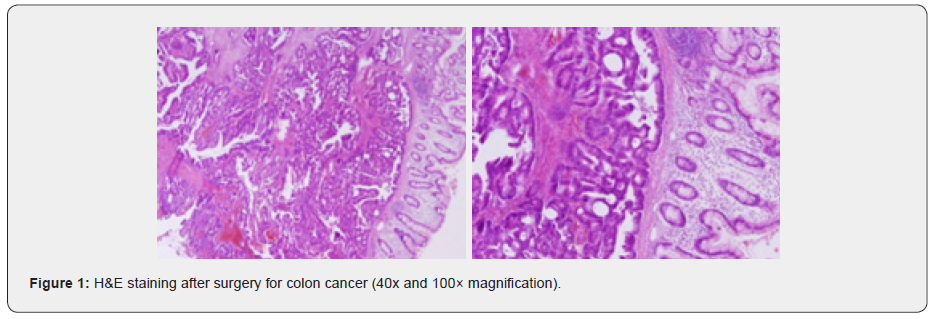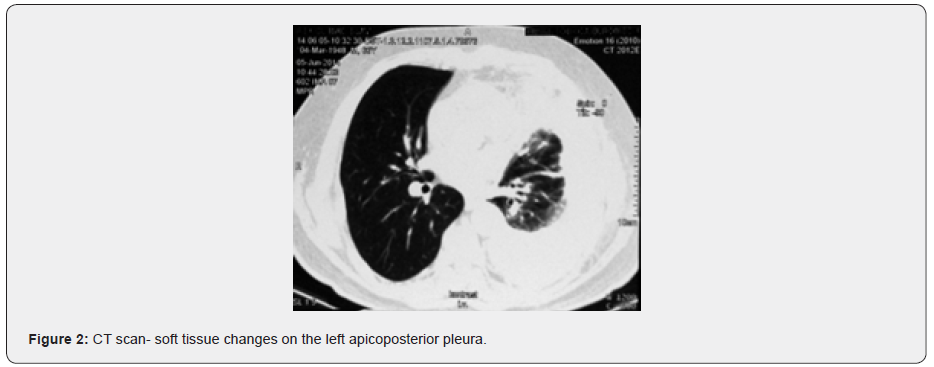Case Report of Rare Presentation Double Primary Tumor - Colon Carcinoma and Malignant Pleural Mesothelioma
Jankovic J1,2*, Djurdjevic N2, Jandric A2, Mitic J2 and Bojic Z2
1 Faculty of Medicine, University of Belgrade, Serbia
2 Clinic for Pulmonology, University Clinical Center of Serbia, Serbia
Submission: September 16, 2022; Published: September 26, 2022
*Corresponding author: Jankovic J, Faculty of Medicine, University of Belgrade & Clinic for Pulmonology, University Clinical Center of Serbia, Serbia
How to cite this article: Jankovic J, Djurdjevic N, Jandric A, Mitic J, Bojic Z. Case Report of Rare Presentation Double Primary Tumor - Colon Carcinoma and Malignant Pleural Mesothelioma. JOJ Case Stud. 2022; 13(5): 555872. DOI: 10.19080/JOJCS.2022.13.555872.
Abstract
We present case of 64-years old woman, who was radically operated because of rectosigmoideal adenocarcinoma. One year after operation because of pleural effusion of the left side appeared, blind pleural biopsy performed. At first pathological finding was metastatic adenocarcinoma from colon origin. Due to radiographic progression, pleural biopsy was repeated and after a detailed immunohistochemical analysis, the diagnosis of malignant pleural mesothelioma was confirmed. Because of locally advanced disease and deterioration of general condition, surgical treatment of malignant pleural mesothelioma was not established effusion. We can conclude that is a very rare association between colon cancer and malignant pleural mesothelioma. Only early diagnostic procedures of malignant pleural mesothelioma can provide treatment and longer-term survival.
Keywords: Ectopic pregnancy; Scar ectopic; Cervical ectopic; Caesarean section; Obstructed labour; Maternal morbidity
Introduction
Colon carcinoma is one of the three most common malignant tumors (after breast and lung tumors) [1]. In contrast, pleural mesothelioma is one of the rarest malignant tumors [2]. The presence of a second malignant tumor in a patient with a preexisting malignancy or tumor that existed in the recent past, represents a double primary tumor [3]. This paper presents a case of a double primary tumor of the colon and malignant pleural mesothelioma.
Introduction
We present a case report of 64 years old woman, a non-smoker, admitted to the Pulmonology Clinic for the diagnosis of radiographically verified pleural effusion on the left side. The symptoms that she mentioned during the examination were pain in the left side of chest, cough and fatigue.
She had a resection of the recto-sigmoid part of colon due to adenocarcinoma a year ago (Figure 1). She did not receive chemotherapy or adjuvant radiotherapy. Also, she has therapy for arterial hypertension. A chest scan was performed, which described soft tissue changes on the left apicoposterior pleura and a pleural effusion of about 8cm (Figure 2). Percutaneous biopsy of the left pleura was performed, 700cc of serohemorrhagic exudate was evacuated. Pathohistological and immuno-histochemical (IHH) staining of biopsies confirmed metastatic adenocarcinoma from colon origin. Findings of bronchoscopy and colonoscopy were normal.
Four cycles of chemotherapy were administered (Fluorouracil/Leukovorin protocol). Due to the progression of the pleural effusion after the therapy and the worsening of the general condition, a percutaneous biopsy of the parietal pleura was repeated. By IHH analysis and revision of the previous biopsy sample, a diagnosis of malignant mesothelioma of the pleura was made (Figure 3). Considering the locally advanced disease and deterioration of the general condition, operative treatment was not indicated. Two cycles of systemic chemotherapy were applied. Unfortunately, the fatal outcome occurred soon, four months after the diagnosed pleural effusion.



Discussion
Billroth was the first who published a case of two associated primary malignant tumors in 1869 [4]. Double primary malignant tumors are divided into two categories depending on the interval between diagnoses [3]. The first are defined as synchronous and occur simultaneously or within six months after the first neoplasm, while the second are called metachronous and occur more than six months after the appearance of the first tumor [3].
Considering that the pleural effusion occurred one year after colon surgery, we suspected that it was a metastatic process on the pleura. But considering the fact that the effusion was unilateral and the fact that our patient suffers from arterial hypertension, the possibility of heart failure and parapneumonic effusion was considered in the differential diagnosis. Additional diagnostics (ultrasound of the heart and laboratory analysis) ruled out these causes, and further diagnostics were started.
Patients which already have diagnosed a cancer, have a higher risk for developing de novo carcinoma. That depending on environmental and iatrogenic risk factors (genetic, radiotherapy, smoking) [3]. Our patient was not exposed to asbestos, which is considered the most common risk factor for pleural mesothelioma, and he did not have this risk factor [1].
Non-surgical procedures (thoracocentesis with percutaneous pleural biopsy) and surgical methods (pleuroscopy and videoassisted thoracoscopy) are using in the diagnosis of pleural effusions [5]. Despite the mentioned procedures, about 20% of pleural effusions remain without a pathohistological diagnosis [6].
For a precise pathohistological diagnosis, IHH analysis is necessary to distinguish mesothelioma from metastatic adenocarcinoma of the colon. Common markers for mesothelioma and colon cancer are calretinin, WT-1, CK7, CK5/6, vimentin and D2-40, while specific for colon adenocarcinoma are CK20, villin, monoclonal CEA, CDX-2, Moc31 [7].
From the mentioned analyses, staining for malignant mesothelioma Calretinin (+++), HBME-1(+++), Cytokeratin5 (+++), WT-1(++), Cytokeratin 7(-), was proven in our patient. while the markers for colon adenocarcinoma CDX-2 (-), Cytokeratin 20 (-) were negative, as were the markers TTF-1(-) for metastatic lung adenocarcinoma.
The treatment of malignant mesothelioma depends on the general condition of the patient, the stage of the disease [8]. Radically operated patients due to colon cancer have the possibility of longer survival in a five-year follow-up with a survival rate of around 68% [9] compared to patients with radical surgery due to malignant pleural mesothelioma, where five-year survival is less than 10% [10]. The explanation may be the high degree of aggressiveness of malignant pleural mesothelioma.
The approach to diagnosis and treatment of malignant pleural mesothelioma should be multidisciplinary with precise pathohistological diagnosis. Early diagnosis enables treatment, improves quality of life and prolongs survival time.
Conclusion
A case of a rare combination of two primary tumors, a malignant tumor of the colon and pleura, is presented. Only early diagnosis of malignant pleural mesothelioma and radical surgical treatment can enable longer survival. Regular controls of the patient after surgery should be aimed not only for detecting the relapse of the underlying disease, but also for the eventual detection of another primary tumor.
References
- Sung H, Ferlay J, Siegel RL, Laversanne M, Soerjomataram I, et al. (2021) Global Cancer Statistics 2020: GLOBOCAN Estimates of Incidence and Mortality Worldwide for 36 Cancers in 185 Countries. CA Cancer J Clin 71(3): 209-249.
- Nadal E, Bosch‑Barrera J, Cedrés S, Coves J, García‑Campelo R, et al. (2021) SEOM clinical guidelines for the treatment of malignant pleural mesothelioma (2020). Clinical and Translational Oncology 23(5): 980-987.
- Bagri PK, Singh D, Singhal MK, Singh G, Mathur G, et al. (2014) Double primary malignancies: a clinical & pathological analysis report from a regional cancer institute in India. Iran J Cancer Prev 7(2): 66-72.
- Irimie A, Achimas-Cadariu P, Burz C, Puscas E (2010) Multiple primary malignancies--epidemiological analysis at a single tertiary institution. J Gastrointestin Liver Dis 19(1): 69-73.
- Jany B, Welte T (2019) Pleural Effusion in Adults-Etiology, Diagnosis, and Treatment. Dtsch Arztebl Int 116(21): 377-386.
- Ferreiro L, Toubes ME, San José ME, Suárez-Antelo J, Golpe A, et al. (2020) Advances in pleural effusion diagnostics. Expert Rev Respir Med 14(1): 51-66.
- Cury PM, Butcher DN, Fisher C, Corrin B, Nicholson AG (2000) Value of the Mesothelim-Associated Antibodies Thrombomodulin, Cytokeratin 5/6, Calretinin and CD 44 H in Distinguishing Epithelioid Pleural Mesotehlioma from Adenocarcinoma Metastatic to the Pleura. Mod Pathol 13(2): 107-112.
- T Lababede O, Meziane MA (2018) The eighth edition of TNM staging of lung cancer: reference chart and diagrams. Oncologist 23(7): 844-848.
- Kong L, Peng J, Li J, Wang F, Li C, et al. (2019) Prolonged surveillance of colorectal cancer patients after curative surgeries beyond five years of follow-up. Ann Transl Med 7(21): 608.
- Woodard GA, Jablons DM (2020) Surgery for pleural mesothelioma, when it is indicated and why: arguments against surgery for malignant pleural mesothelioma. Transl Lung Cancer Res 9(Suppl 1): S86-S91.






























